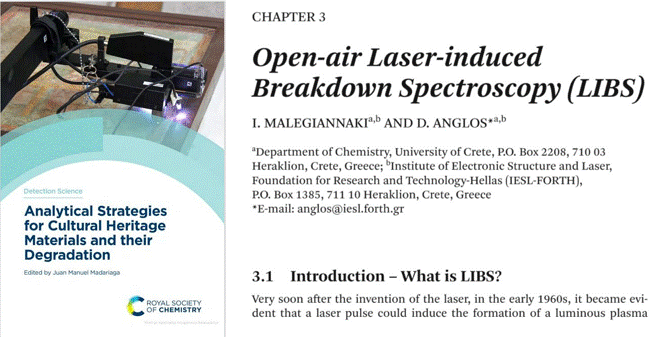“Open-air Laser-induced Breakdown Spectroscopy (LIBS)”
January 07, 2021
A new book chapter was published recently in the book “Analytical Strategies for Cultural Heritage Materials and their Degradation” (Editor: Juan Manuel Madariaga, Royal Societ of Chemistry, London (2021)) presenting work of the Photonics for Heritage Science (PhoHS) of IESL-FORTH and the Department of Chemistry, University of Crete.
The book chapter entitled “Open-air Laser-induced Breakdown Spectroscopy (LIBS)” by Irene Malegiannaki and Demetrios Anglos reviews LIBS as a rapid and versatile spectrochemical technique for elemental analysis of materials and objects in the field of Cultural Heritage (CH. LIBS has been widely employed in the analysis of archaeological and historical objects, monuments, and works of art for assessing the qualitative, semiquantitative, and quantitative elemental content of diverse materials such as pigments, pottery, glass, stone, metals, minerals, biomaterials, and fossils. For the studies that require measurements to be on-site, open-air mobile, hand-held, remote, or even underwater LIBS systems have been developed, due to the unique characteristics of the LIBS technique. In this chapter, the basic principles of the LIBS technique are outlined and technical details are presented concerning the instrumentation, spectroscopic data analysis and interpretation, and how LIBS can be combined with other techniques to obtain integrated compositional and structural information about materials and objects. Case studies are presented to illustrate how LIBS has been employed in support of archaeological science, art history, and conservation studies.
Read the full publication here: doi.org/10.1039/9781788015974-00045


